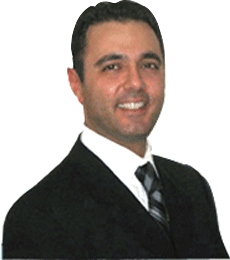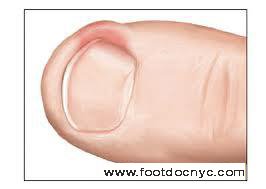Corns and Calluses - Removal & Surgery, General Information, Explanation and Q&A
By Isaac Tabari
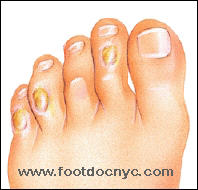
What are corns and calluses?
Corns and calluses are hardened / thickened skin areas. Corns commonly develop between the toes or on top of the toes. Calluses usually develop on the bottoms (soles) of the feet, although they can form on the sides or on the toes, as well. The difference between corns and calluses is that corns have a nucleus (hard center) and callus is diffused. Corns and calluses are very common foot conditions, especially in older people. These conditions can start out being annoying at first, but can become very painful if left untreated. Corns & calluses can become inflamed and infected, especially in people with poor blood flow to the feet. Corns and calluses are often preventable with proper footwear, orthotics, etc. When they do form, however, these conditions respond well to treatment.
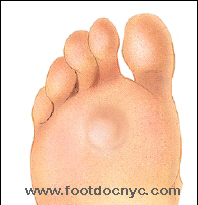
Causes of corns and calluses
Corns and calluses develop due to improper friction or pressure, such as when skin rubs against skin ( often happens between adjacent toes) or when shoes or socks rub against a toe or some other part of the foot.
Wearing ill-fitting shoes is the number one cause of corns and calluses. Tight shoes are especially likely to increase pressure on the skin. Shoes that are too loose cause corns and calluses as well because the foot slides in them and similarly rub against the shoe. High-heel shoes that place the body weight on the front of the foot and jam the toes against the front of the shoes are another cause of corns/callus.
Also, fat and muscle tissue on the bottom of the feet thin with aging; due to this pointy outgrowths of bone (spurs) and bumpy outgrowths of bone are more likely to press against the skin. When friction or pressure occurs regularly in the same area, a corn or callus forms gradually. Problems such as hammertoes frequently have corns associated with them, since the tops of the affected toes tend to be pressed against the tops of the shoes' toe boxes.
In addition, poorly-fitted socks that create irritation can lead to the development of corns.
Symptoms and diagnosis of corns & calluses
A corn may be soft or hard. It is thickest at its center, or core. A callus is hard and is usually of equal thickness throughout. Some corns and calluses are annoying but without pain. However, most cause at least mild discomfort. Some cause enough pain to make walking difficult. Pain may worsen, and redness and warmth may develop if a corn or callus becomes inflamed and infected. Warts may resemble corns and calluses and may cause similar symptoms.
- Thick rough areas of skin
- Hardened raised bump
- Tenderness or pain under skin
- Flaky, dry or waxy skin
Your podiatrist will diagnose a corn or callus by recognizing its typical appearance during a physical examination of the foot.
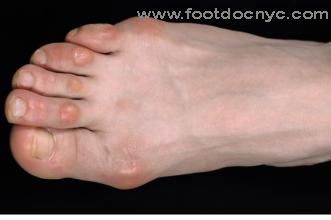
Prevention of corns & calluses
Wearing properly fitting shoes is the best way to prevent corns and calluses. Shoes should be the right size, i.e. long enough and spacioius enough in the toe area so that there is no pressure on the tops of the toes. Spurs or bumpy of bone can interfere with the fit and comfort of shoes. This discomfort can sometimes be lessened by affixing into the shoe a soft material, such as moleskin, lamb's wool, felt, or foam padding. If these measures are unsuccessful, your NYC podiatrist / foot doctor can sometimes modify a shoe or make a custom orthotic insole to reduce friction and pressure at certain points.
People with diabetes or poor blood circulation to the feet are at greater risk of complications from corns and calluses. Seek your podiatrist's - foot doctor's advice on proper care for corns and calluses if you have one of these conditions.
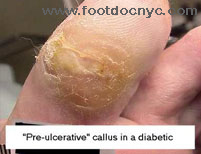
Treatment of corns & calluses
If a corn or callus becomes very painful or inflamed, see your foot doctor. If you have diabetes or poor circulation, call your podiatrist. Even a relatively minor injury to your foot could lead to an infected open sore (foot ulcer) that's difficult to heal.
Your Podiatrist will treat a corn or callus by using a scalpel to shave or pare away the thickened skin. Soft padding over the area is usually recommended to reduce pressure and protect the area where the corn or callus has been removed as well as to protect the surrounding healthy skin. The doctor may suggest adding a cream that softens thickened and hardened skin (emollient cream) to the padding. The podiatrist may also corns and calluses NYC foot doctor podiatristhelp the person modify his shoes to reduce pressure on the area where the corn or callus has been removed, or make a custom orthotic insole, or recommend alternative footwear.
After a corn or callus has been removed, it will not likely recur if the person can find and continue to wear footwear that fits properly.
Trying to self-treat with razor or knife blades, or nonprescription preparations of salicylic acid should NOT be attempted because of the risk of injury and infection.
***This material is only provided as helpful information and not as medical advice and you should consult with your foot doctor or another medical doctor for a professional diagnosis. ***
For more information on foot and ankle podiatry services and to make an appointment with best NYC podiatrist - foot doctor, please call us at (212) 288-3137 or click below to make an appointment:

|






